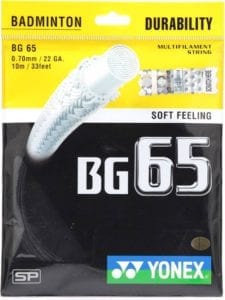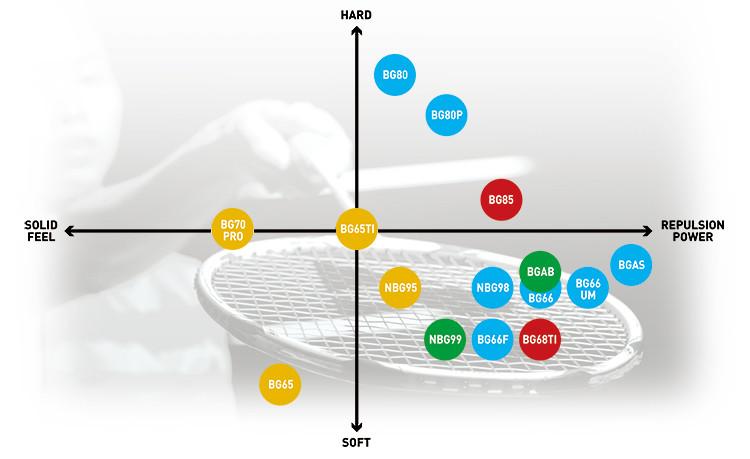If you have been reading some of my reviews, you may have noticed that I haven’t given any stringing recommendations to any of them. This is because the string is fully up to what kind of player you are. If you have no idea how to choose any strings, you’re in the right place.
Badminton Strings
For the sake of simplicity in explaining, I will be focusing on Yonex strings in this article. Yonex likes to give ratings for their strings in factors that are Repulsion Power, Durability, Hitting Sound, Shock Absorption, and Control. They also split their strings into different categories being Control, Power, and Durability for easier classifying.
Power
- BG80
- BG66 Ultimax
- BG80 Power
- NBG98
- BG Aerosonic
- BG66 Force
Durability
- BG65
- BG65 Titanium
- NBG95
Control
- NBG99
- BG Aerobite
Determining the string will depend on your play style and what you like. A general recommendation is that beginners start out with a more durable string such as the BG65 because weaker strings break when you mishit on the edges more easily. Once you become more advanced you could move on towards control and power strings if you’d like. Also, look at the thickness of the string. It is what determines the durability; thinner strings break more easily and thicker ones are more durable.
Another chart tells you about each string’s feel. This one is hard to describe and it’s much better to just play with the strings.

But basically, it shows you which strings feel hard or soft, have high repulsion power, and/or solid feel. Don’t worry about these factors too much because what’s truly important is the tension. What kind strings you like will come from playing more but I recommend BG65 if you really have no idea.
Tension
The tension is the most important part of choosing your badminton string and stringing it. Here’s a comparison between lower tensions and higher tensions.
Lower Tensions (18-24lbs)
A lower tension means that the strings are looser which results in less control and accuracy but it also creates more repulsion which means a player can generate more power without using much strength. Having looser strings also creates a larger sweet spot so that it makes it easier to hit shuttles. The strings become more durable as well so off-center miss hits at the sides of the racket does not break as easily.
This concludes to beginners should use lower tensions because they are not as accurate in their shots and do not have good enough hitting technique to generate power yet.
Higher Tensions (24-30lbs)
A higher tension basically gives the opposite results of a low tension. The tighter string bed allows for more accuracy in shots, less power, less durability, and smaller sweet spot.
At first glance, it may seem like stringing your racket at a lower tension is the most optimal for all players but as you get more advanced and build good technique, the control and placement of the shuttle becomes the most important part of your game. All the extra power and durability is not needed because you will have good technique which means you’ll hit the sweet spot of the racket almost all the time and won’t need the extra power boost. This is why many professionals string at tensions over 27lbs.
Also, note that the tension of the string will get looser as time goes on and it’s inevitable that you will need to restring your racket. These recommendations are meant to protect your racket from completely breaking, not guaranteeing that you will never have to change your strings but the recommendations definitely prolong the life of the string. It’s why I mentioned you can try them all out especially since stringing costs about $10 to $50 CAD depending where you are and what string.
My Recommendations
On every racket there’s a recommended string tension usually in a range like 17-24lbs, 20-28lbs etc. This is the recommendation to ensure that your racket does not break when stringing. I recommend you generally follow this unless you are sponsored or rich. Stringing at a tension higher than the recommended will void the racket’s warranty so please string at your discretion.
 20-28lbs is the recommendation of this racket as seen next to the 3U
20-28lbs is the recommendation of this racket as seen next to the 3U
Here’s my stringing recommendation:
- Beginner: 17-20lbs
- Intermediate: 20lbs-24lbs
- Advanced: 24lbs-27lbs or whatever the maximum recommended stringing tension is
- Professional: 27lbs-30lbs+ or whatever is more than the maximum/whatever you like most since you’re a professional so you must have been playing for quite some time
What to Avoid
There are some things I want you to avoid though when choosing a string. The first thing is, don’t go for the string that’s super thin and recommended for the “world’s top players” if you’re a beginner/intermediate. Because when they have the lowest durability of other strings, they really do have bad durability. When I got my Yonex Nanoray Z Speed and Duora Z Strike, I strung them at their respective maximum 3U tensions, 27lbs and 28lbs, and they broke within the first two weeks! This is because of a few off-timed jump smashes in which I hit the edges of the string.
But this isn’t even the worst case scenario. I’ve only had to replace the strings which is quite common for any badminton player that regularly plays. I had a friend whose racket completely snapped in half due to its high tension!
I had a little cocky friend who believed he was super good at badminton (and everything else) and strung his racket at 31lbs. His technique was not the best and he would often whip his racket super hard to generate power. But bad technique prevented him from generating that power he desired. One day he whipped his racket super hard when hitting a shot that his whole frame snapped! Which meant for the rest of the day there was a broken racket ready to impale people with metal fragments at any time. Rackets breaking like that at high tensions can sometimes spell disaster.
Avoiding ego and choosing what you believe is safe and good for you is the most optimal choice. My Yonex Voltric Z Force II strung at 24lbs with NBG99 hasn’t had to be strung in 7 months now! Although it’s probably due for a change soon.
Conclusion
The general gist of this article is choose a string based on play style (if you don’t know, just choose durability) and string the tension lower if you’re a beginner and higher if you’re advanced. Don’t string at extremely high tensions and break the warranty of your racket unless you have been playing for a very long time at a high level and if you’re used to it.
If you have any questions, comments, or your own personal experiences, please leave them down below. As always, good luck in your games and have a great day!


Hi Kevin,
I want to comment on your website. First of all, I am so excited to find someone as passionate about the game of badminton as I was when I was in high school. No, I didn’t play for very many years. And no I never got so good that I won anything. But I did love the game.
On to the comment. I was very impressed with all the detail to each part of the equipment to the way to play was address. You gave a lot of information. I did note on most of your posts, however, that you might want to use a grammar checker. There were several minor errors.
As far as how the pages were set up, that was beautiful. I have bookmarked your site so I can get myself back into some form of active life again.
Love to see others that love badminton! It’s definitely a good way to stay in shape. I might even write a post about the benefits of playing badminton. As for grammar, haha, still working on it.
Thanks for your comment!
Hi there Kevin, brilliant website, thanks for the help! I just had a quick question. I have had the same cheaper racket racket with the same strings for 10 years! So when I found out about a YONEX sale I got super excited. I would class myself as an intermediate player but when I recently purchased a an ASTROX 77 3U4, my excitement was too much to wait and research string tensions. Therefore I relied on the advice of the shop I was buying from. I believe the recommendations for this racket was 20-28lbs and it has been strung with YONEX aerobite at 24lbs. What I wanted to know is if this is safe or appropriate for me or the racket, as I am new to the more technical side of the sport.
Hi Jacob, glad you like the site! The advice of the shop you were buying from is perfect. You can’t go wrong with stringing your Astrox 77 with Yonex Aerobite strings at 24lbs. What I will say though is that if you had the same racket and strings for 10 years, you may be surprised if your racket strings break within a month or two months (depending on how much you play). Don’t worry, because this is totally normal.
Hi Kevin, your review is definitely benefits me and I am glad to knowing you from this website.
I have a few questions need to learn from you.
What is your recommendation for string & tension for “head light” & “head heavy”? I am a lady player in between beginner & an intermediate.
Recently, I bought 2 pcs of Victor rackets. Both were recommended by the different shop.
1. Thruster ryuga 2 (Head heavy), (Strung Victor BG66 & tension 23lbs). Issue I was encountered (Unable to press down the racket head for smashing). But no issue to hit the shuttlecock to the backcourt.
2. Auraspeed 90F (Head light), (Strung BG63 & tension 24lbs) = Issues I was encountered (I won’t feel good to play with this racket, it’s because too light and it unable to hit to the backcourt & smashing). I am not sure if Strung & tension for this racket is not correct.
I look forward to hearing from you soon.
Hi Elizabeth, thank you for reaching out! To answer your question, string and tension don’t have much to do with the rackets’ head light or heaviness. The issues you’re facing are pretty normal and have more to do with your technique and strength. It’s generally easier to hit stronger shots with a head heavy racket because the weight naturally allows you to swing faster. The downside is that it’s more difficult to bring up and down and control. Head light rackets are the opposite.
For you, it sounds like the head heavy racket will be a bit better and practicing smashes, particularly when you contact the bird, will help you solve your issues. Hope this helps!
Hey brother is woods carbolite a good racket and what string and tension should I use with it I am an intermediate level player. I basically want to get good backcourt clearance and good smashes
Hey, I personally haven’t heard of the Woods Carbolite racket. In general, you might want to look at a tension of 24lbs to start with and probably use the Yonex BG65. You can’t really go wrong with that combination, but do experiment and find what suits you.